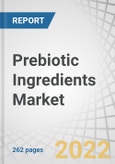The global market for prebiotic ingredients is estimated at USD 6.3 Billion in 2022; it is projected to grow at a CAGR of 11.7% to reach USD 10.9 Billion by 2027. Awareness about prebiotics has gained popularity in recent years, stimulating scientific as well as industrial interest.Rising Number of Local Manufacturers for Components is Driving the Growth of the Lateral Flow Assay Components Market
Wide uses of prebiotics as nutraceutical ingredients and increased awareness; these two points has acted as major drivers for the growth of this market. While the high R&D cost and stringent regulations by the government have acted as a challenge and restrain to the market. In recent years, the trend for prebiotics has been incorporating these ingredients in food and beverage items. Thus, making the food and beverage segment the largest one in 2022.
The Food & Beverages segment, by application, is projected to observe the fastest growth in the prebiotic ingredients market throughout the forecasted period
Prebiotic ingredients can be easily incorporated into daily diets through dairy, bakery, meat, cereal, and confectionery foods; they do not change the texture or taste of these products when used as an additional ingredient. The regular consumption of prebiotics increases immunity & reduces risks of certain diseases and conditions such as diarrhea, osteoporosis, obesity, cardiovascular diseases, and colon cancer.
The inulin segment by type is estimated to account for the largest market share in the prebiotic ingredients market
Inulin & fructooligosaccharides (FOS) are used in low-fat dairy and bakery & confectionery products such as yogurt, low-sugar ice cream, low-fat dairy desserts, fresh cheeses, milk beverages, creams, and dips to improve texture and taste. Inulin is used as a fat replacer, while FOS is used as a sugar replacer with an extra stabilizing effect on mousse emulsions. Inulin is considered an excellent product with the added advantage of its organoleptic properties, providing considerable benefits through its fibrous characteristics.
The roots, by source segment is projected to attain the fastest market growth in prebiotic ingredients over the forecast period.
Roots such as raw chicory root (cichorium intybus), jicama root (pachyrhizus erosus), Jerusalem artichoke root (helianthus tuberosus), black salsify root (scorzonera hispanica), Andean yacon root (smallanthus sonchifolius), and burdock root (arctium lappa) have prebiotic content. Raw chicory root contains maximum prebiotic fiber, that is, inulin, among all other roots. Chicory roots have also been linked to curing pulmonary diseases or tuberculosis, cancer, cough, and wounds. It is sometimes also used as a coffee substitute.
Break-up of Primaries
- By Ingredient Manufacturer: Managers: 50%, Junior level employees: 20%, Director: 30%
- By Designation: Managers: 30%, CXOs : 26%, and Executives: 44%
- By Country: US: 20%, UK: 20%, India: 55%, China: 5%
Leading players profiled in this report
- Beneo (Germany)
- ADM (US)
- DuPont (US)
- Friesland Campina (Netherlands)
- Ingredion (US)
- Samyang Corp (South Korea)
- Nexira (France)
- Beghin Meiji (France)
- Tate & Lyle (UK)
- Yakult (Japan)
- Kerry PLC (Ireland)
- Fonterra Ltd (New Zealand)
- Royal Cosun (Netherlands)
- Roquette Freres (France)
- Cosucra Groupe Warcoing SA (Belgium)
Research Coverage
This report segments the prebiotic ingredients market on the basis of application, source, type, and region, brand and functionality. In terms of insights, this research report focuses on various levels of analyses - competitive landscape, end-use analysis, and company profiles - which together comprise and discuss the basic views on the emerging & high-growth segments of the prebiotic ingredients market, the high-growth regions, countries, government initiatives, market disruption, drivers, restraints, opportunities, and challenges.
Reasons to buy this report
- To get a comprehensive overview of the prebiotic ingredients market
- To gain wide-ranging information about the top players in this industry, their product portfolios, and key strategies adopted by them
- To gain insights about the major countries/regions, in which the prebiotic ingredients market is flourishing
Table of Contents
1 Introduction
2 Research Methodology
4 Premium Insights
5 Market Overview
6 Regulations
7 Prebiotic Ingredients Market, By Brand
8 Prebiotics Ingredients Market, By Functionality
9 Prebiotic Ingredients Market, By Bacterial Activity
10 Prebiotic Ingredients Market, By Type
11 Prebiotic Ingredients Market, By Source
12 Prebiotics Ingredients Market, By Application
13 Prebiotics Ingredients Market, By Region
14 Competitive Landscape
15 Company Profiles
16 Appendix
List of Tables
List of Figures
Companies Mentioned
- Advanced Microdevices Pvt. Ltd.
- Ahlstrom-Munksjö
- Axiva Sichem Biotech
- Ballya Bio
- Cytodiagnostics
- Danaher Corporation (Pall Corporation and Cytiva Life Science)
- DCN Diagnostics
- Fortis Life Sciences
- Hangzhou Cobetter Filtration Equipment Co. Ltd
- Maxim Biomedical
- Merck Kgaa
- Neenah Gessner
- Nupore Filtration System
- Runbio Biotech Co. Ltd.
- Sartorius Stedim Biotech
- Senova Gmbh
Methodology

LOADING...
Table Information
| Report Attribute | Details |
|---|---|
| No. of Pages | 262 |
| Published | February 2022 |
| Forecast Period | 2022 - 2027 |
| Estimated Market Value ( USD | $ 6.3 Billion |
| Forecasted Market Value ( USD | $ 10.9 Billion |
| Compound Annual Growth Rate | 11.7% |
| Regions Covered | Global |
| No. of Companies Mentioned | 16 |









